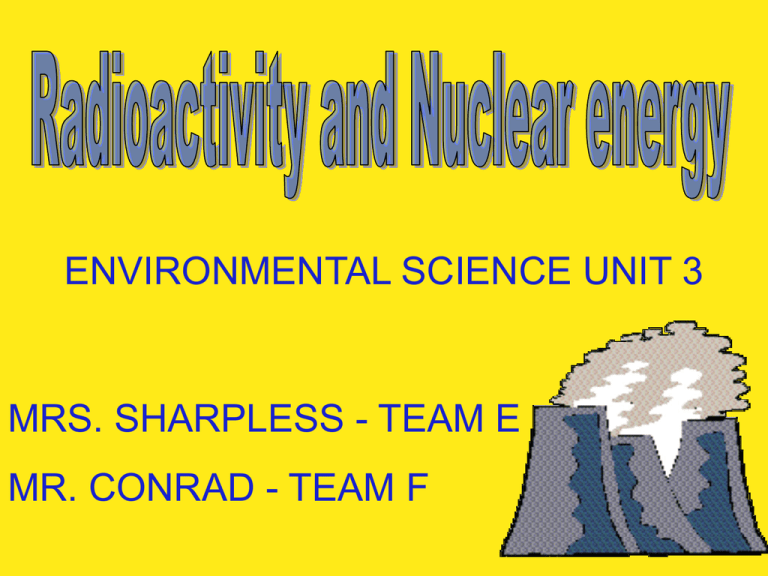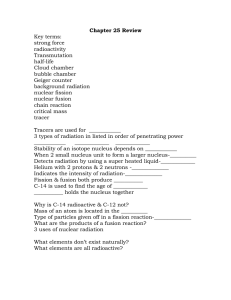ENVIRONMENTAL SCIENCE UNIT 3 MRS. SHARPLESS - TEAM E
advertisement

ENVIRONMENTAL SCIENCE UNIT 3 MRS. SHARPLESS - TEAM E MR. CONRAD - TEAM F Radiation was discovered purely by chance ………. He put a couple of photographic plates in a drawer next to a rock. Days later he discovered that the plates had patches on them where they had been developed. WHAT DO YOU BELIEVE HAPPENED HERE? The “rock” in his desk contained URANIUM in it. Becquerel discovered that it gave off invisible rays which developed the film plates. All nuclear energy begins in the area of the atom called the …… The central “core” of the atom. Contains PROTONS and NEUTRONS. Reactions that produce energy and involve the nucleus of an atom are called NUCLEAR REACTIONS, and produce a tremendous amount of energy. Developed a formula to describe how matter changes into energy. When matter is turned into energy, large amounts of energy are released. E = energy M = mass C = speed of light (squared) WHAT MAKES SOMETHING “RADIOACTIVE” ANYWAY? The atoms that make up the substance must be giving off nuclear particles (protons and neutrons) and energy. The spontaneous release of nuclear particles and energy. Isotopes - Atoms which possess the same atomic number, but different mass numbers. (Same number of protons, different number of neutrons) 1 2 3 1 1 1 Stable Isotopes -Atoms that do not release protons or neutrons from the nucleus and ARE NOT RADIOACTIVE. Unstable Isotopes - Atoms that spontaneously release protons and neutrons from its nucleus. These isotopes ARE RADIOACTIVE. THERE ARE THREE TYPES OF PARTICLES AND ENERGY GIVEN OFF BY RADIOACTIVE ELEMENTS 1.ALPHA PARTICLES Type of radiation where the particles possess a positive - charge, cannot even penetrate paper, has the most mass, and moves slowly. If you could see an alpha particle, it would look just like a helium nucleus. Two protons, two neutrons. THERE ARE THREE TYPES OF PARTICLES AND ENERGY GIVEN OFF BY RADIOACTIVE ELEMENTS Type of radiation where the BETA PARTICLES - particles have a negative charge, penetrates living tissue, and has less mass but moves quicker than an alpha particle. If you could actually see a beta particle it would appear to be one “free” electron capable of moving anywhere. THERE ARE THREE TYPES OF PARTICLES AND ENERGY GIVEN OFF BY RADIOACTIVE ELEMENTS The only type of radiation which is GAMMA RAYS - “energy” instead of particles. Travels at the speed of light, has no mass, is neutral in charge, and penetrates just about every substance. POWERFUL!!!!!! Since Gamma rays are energy only and travel so quickly, you would not see them even if you could! Radiation strips electrons out of atoms. This causes your cells to malfunction or die. High levels of radiation exposure causes burns, and lowers your number of white blood cells, it could also cause cancer and other health problems. HOW CAN YOU TELL IF THERE IS RADIATION PRESENT AROUND US? ARE WE IN DANGER!!! There is radiation all around us, but fear not!!!! Almost all of it is low-level radiation. We can use radiation detection devices to tell how much radiation might be present in a given location. THERE ARE THREE DEVICES WE WILL DISCUSS 1. Cloud chamber - Contains air inside which is thick with water vapor. A radioactive element is placed inside and forms a vapor trail. The size of the vapor trail tells scientists what type of radiation is given off. THERE ARE THREE DEVICES WE WILL DISCUSS 2. Geiger counter - Device which contains a tube of argon gas with a wire inside. Radiation causes the gas to get “excited” and electricity moves through the wire to a speaker that “clicks”. The louder/faster the clicks, the more radiation present. THERE ARE THREE DEVICES WE WILL DISCUSS 3. Film badge - Item worn by people who work with radiation daily. Made of photographic film. Chemicals in the film react to the radiation, show the level of radiation the person was exposed to. So if radioactive elements are losing protons and neutrons out of the nucleus (causing radiation) what happens to the element? THE ELEMENT EXPERIENCES ….. The element changes form because the number of protons and neutrons are now different. 238 234 --> 92 232 --> 90 88 238 234 232 --> --> 90 92 230 --> 228 --> 86 88 226 --> 84 82 What did you notice about the elements you ended up with as you continued this process? Change from one element to another through the spontaneous release of nuclear particles and energy. The time it takes for 1/2 of a radioactive element to decay. Every radioactive element has a unique half-life. (some are in seconds and some are billions of years.) On the island of Bikini Atoll, scientists back in the 1950’s tested nuclear bombs for the government. Today, nobody is still allowed to return there because it is STILL RADIOACTIVE!! Iodine-137 has a half-life of 23 seconds. Calculate how much of the 302 grams of iodine-137 remains after 138 seconds. STEP 1 - CALCULATE HOW MANY HALF-LIVES YOUR ISOTOPE WILL GO THROUGH. DIVIDE TOTAL TIME BY HALF-LIFE TIME. 138 sec / 23 sec = 6 half-lives STEP 2 - DIVIDE YOUR ORIGINAL AMOUNT OF YOUR ISOTOPE BY TWO AS MANY TIMES AS YOU HAVE HALF-LIVES (YOUR ANSWER IN STEP 1) 302 g / 2 = 151g / 2 = 75.5 g / 2 = 37.75 g / 2 =18.87 g / 2 = 9.4 g / 2 = 4.72 grams of iodine-137 left. The splitting of an atom’s nucleus into two smaller nuclei. HOW FISSION WORKS: The fuel for this reaction is a large radioactive and unstable atom such as Uranium 235, or U-235. A neutron is shot at the U-235 atom at a high speed, and splits apart the U-235 atom. Tons of nuclear energy is released as well as three more neutrons. Nuclear power plants use this fission reaction to produce electricity. --> WHAT WOULD HAPPEN IF THE 3 RELEASED NEUTRONS RAN INTO 3 MORE U-235 ATOMS? A nuclear “chain reaction” occurs. Nuclear power plants keep this chain reaction under control, however an explosion can occur if this reaction is out of control. The atomic bomb is an example of this. Fission Reaction Krypton-92 nucleus neutron energy neutron energy neutron Neutron Uranium-235 nucleus Barium-141 nucleus The fusion process occurs naturally in our sun. This is how the sun produces it’s heat and light energy. In fusion, two hydrogen atoms collide together at high temperatures and fuse (melt) together to form a larger helium atom. The combining of two smaller nuclei to form one large nucleus. This reaction produces five times more energy than fission. --> Fusion Reaction Neutron and energy H-2 nucleus H-3 nucleus Helium nucleus 1. Fuel (Uranium) is in limited supply. 2. Reaction can be controlled. 3. High-level radioactive waste products are made. 4. Waste products are large and take years to decay to safe levels. 1. Fuel (Hydrogen) can be taken from water, which we have great supply of. 2. Reaction needs high temperatures, cannot be easily controlled. 3. Produces low-level safe waste products. 4. It takes more energy to get fusion started than what you get out of it. Fission vs. Fusion Comparing Nuclear Fission and Nuclear Fusion Type of Reaction Process Products Fission One nucleus splits Two nuclei, neutrons, energy Fusion Two nuclei fuse One nucleus, neutrons, energy There are two nuclear power plants very close to our area. Can you tell me where they are? A nuclear power plant uses the heat produced by the fission reaction (breaking uranium atoms) to produce steam. The steam turns a large set of turbine blades which then turns a generator producing electricity for us to use. 1. Fuel - Uranium-235 provides the nuclear energy needed to heat the reactor vessel or core. Made in pellets the size of your fingernail. 2. Reactor vessel (core) - The section of a nuclear power plant where the fission reaction occurs. 3. Fuel rods - The uranium-235 pellets are placed in these. Many rods are bundled together in the reactor vessel (core). 4. Control rods - These are placed within the fuel rods. They are usually made of the element Cadmium. They control the speed of the fission reaction. 5. Cooling water (coolant) - Surrounds the control and fuel rods inside the core. This water is heated by fission, and pumped into the heat exchanger. 6. Heat exchanger - Hot radioactive water inside the pipe makes contact with normal water in the tank. The normal water is heated up, and turns to steam. 7. Steam turbine - Contains sets of fan blades that turn when steam is shot through them. 8. Generator - A magnet connected to the turbine spins inside giant coils of wire producing electricity. Are we done yet !? Last one - I promise!! 9. Cooling Tower - A holding tank where the heated water collects to cool down. When the water is cooled, it is pumped back into the plant to be used again. Steam rises from the tower - not smoke!!!! THE NUCLEAR POWER PLANT Meltdown - When temperatures inside the reactor core get too hot, the fuel rods melt together causing a possible explosion/release of radiation. Chernobyl, Russia (1986) Three Mile Island, PA (1979?) Yucca Mountain , Nevada This proposed site by our government is where nuclear power plants will eventually send their high-level wastes. The wastes would be put into metal air-tight containers and placed into underground caverns dug under this mountain.




